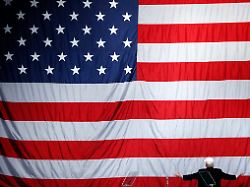Dates, dates, candidates
This is how the US primaries work
January 15, 2024, 3:33 p.m
The pre-selection for the US presidential race begins: Deep in the interior of the USA, the starting signal for the race for the top position among the Republicans is given in the state of Iowa. Who will run against incumbent Biden?
In the US state of Iowa, the long series of party primaries for the 2024 presidential election begins on Tuesday night (German time). In the Republican camp, it is about who will run as the official candidate against the incumbent US President Joe Biden next fall becomes.
The best-known challenger in the Republican field is Biden’s predecessor in office, former President Donald Trump. The 77-year-old is well ahead of his rivals in the nationwide surveys, with approval ratings currently at over 60 percent. However, his behavior after being voted out four years ago got him into legal trouble all the way to the Supreme Court: The US Supreme Court has yet to decide whether Trump can even run for election.
For the Republicans, the field of candidates could thin out further in the event of a clear Trump victory in Iowa. Trump currently has four competitors, of which only two are given real chances: These are the governor of Florida, Ron DeSantis, and the former UN ambassador, Nikki Haley. The – already hopeless – ex-governor of New Jersey, Chris Christie, dropped out of the race a few days ago.
For the Democrats, the primaries are purely a formality; incumbent Biden is certain to be nominated again as a presidential candidate. There is more tension among the Republicans: In Colorado and Maine, courts decided that Trump was not allowed to run in the primary election in these states because of his role in the storming of the Capitol on January 6, 2021.
This was justified by the 14th Amendment to the US Constitution, according to which no person may hold public office if he or she has taken part in an “insurrection or insurrection” against the Constitution after taking an oath to defend it. California, Michigan and Minnesota, however, rejected efforts to remove Trump from the ballot.
The final word in this dispute goes to the Supreme Court, which Trump’s lawyers have appealed to over his disqualification in Colorado. The Supreme Court plans to hold a hearing on the case on February 8th. It is unclear when he will make his verdict.
In any case, the decision will apply not just to Colorado, but nationwide. And until the court has ruled, Trump must remain on the ballot in Colorado, Maine and other states. Colorado and Maine will hold their Super Tuesday primaries on March 5.
Opening in Iowa
Traditionally, the Midwestern state is at the start of the primary election marathon. In a departure from tradition, only the Republicans in Iowa will choose their candidate on January 15th. The Democrats in Iowa, however, will vote by postal vote for the first time. The results of their vote are not due to be announced until March 5th.
The background to the new procedure for the Democrats is an initiative by Biden, who is critical of Iowa’s central role as the starting point of the primary election process – because the state is not exactly representative of the entire country. Iowa is agricultural and has a large white majority.
The second act: New Hampshire
The second round of primary voting will take place on January 23rd in New Hampshire, with both Republicans and Democrats voting. The small east coast state’s second place in the primary election calendar is also a tradition – something Biden also wanted to change. But local Democrats resisted.
Because of the internal dispute, the president did not put himself on the ballot in New Hampshire – this shows Biden’s certainty that he will be nominated even without New Hampshire. Biden only has two internal competitors who also have absolutely no chance: the self-help book author Marianne Williamson and the congressman Dean Phillips.
The “Super Tuesday”
There will be additional primaries in the two weeks after New Hampshire, including in Nevada, South Carolina and Michigan. The voting series reaches a climax on March 5th, on “Super Tuesday”, when voting takes place at the same time in around 15 states, including the two most populous US states, California and Texas.
If Trump clearly wins on this “Super Tuesday” and the Supreme Court doesn’t get in his way, he could possibly already be confirmed as a presidential candidate.
The party conferences
Overall, the primaries run until the beginning of June. The primary election process concludes with party conferences at which the candidates are formally nominated. The state party organizations send the delegates who were elected in the primaries to these meetings. Most of them are tied to the primary election results in their state in their party conference vote.
The Republican convention will take place from July 15th to 18th in Milwaukee, Wisconsin, and the Democratic convention will take place from August 19th to 22nd in Chicago, Illinois.
The choice
The hot phase of the US presidential election campaign begins with the party conferences in July and August. From now on, the competition will no longer be within the parties, but between them. In addition to campaign appearances and the so-called town hall meetings, the highlights include the three television debates between the presidential candidates. The actual election day follows in the fall: on November 5th, the citizens of the USA will elect their next president.
